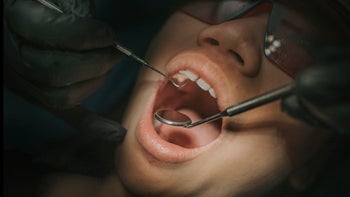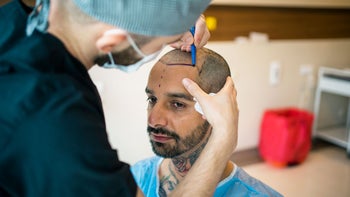
How Much Does a Facelift Cost?
Key takeaways:
A facelift is surgery that tightens the facial skin, leading to a more youthful look.
The average cost of a traditional facelift is $9,281, but that price doesn’t include anesthesia and other related costs.
While insurance does not cover facelifts, you may be able to find financing for the procedure.
Table of contents

Faces get noticed. And loose skin and deep wrinkles are things some people don’t want noticed.
Facelifts, which can make the skin look smoother and tighter, are among the top five cosmetic surgeries performed every year. There were more than 72,000 of these procedures performed in 2022, according to the American Society of Plastic Surgeons. Facelifts are not a new phenomenon, either: They’ve been performed for more than 100 years.
What is the average cost of a facelift?
The average cost of a traditional facelift is $9,281, according to the American Society of Plastic Surgeons. The surgeon’s fee makes up the biggest portion of that cost.
Search and compare options
Here are the average costs of common facelift procedures in different parts of the U.S.:
Deep plane facelift: This procedure can cost between $15,000 and $30,000, according to the Glasgold Group in Princeton, New Jersey. Deep plane facelifts are more invasive, but last longer than traditional facelifts. They are more common in older patients with advanced signs of aging.
Mid-facelift: Elite Plastic Surgery in Tampa, Florida, typically charges $5,000 to $8,300 for this type of facelift.
Mini-facelift: The average cost of a mini-facelift at one Chicago-based plastic surgery center and med spa is $7,150.
Liquid (nonsurgical) facelift: This is not actually a facelift but a combination of injections and other skin treatments. The procedure can range from $2,000 to $5,000, according to a facial plastic surgery center in Ohio.
But how much you actually pay depends on a number of factors, including the type of procedure, where it’s performed, and the costs of anesthesia and other add-ons.
How much does Botox cost? If you’re thinking of having injections to smooth facial wrinkles, check out the factors that can affect the cost of Botox.
Insurance coverage for Botox: Botox injections may be covered by insurance for these medical conditions.
More anti-aging strategies: From laser treatments to injectable medication, here are the top anti-aging approaches that work on wrinkles.
Factors affecting the costs of a facelift
The quoted prices above don’t include all the costs that can be associated with a facelift. Below are seven factors that may impact the total price you pay.
1. Consultation fee
This is the fee you pay simply to meet with the plastic surgeon. Often, this fee is bundled into the cost of the procedure, but sometimes it is a separate cost.
2. Anesthesia fees
This includes the cost of the anesthetic medications and the services of the anesthesiologist treating you. In most cases, general anesthesia is used, but there are other types. General anesthesia is typically more expensive than local anesthesia.
3. Hospital or surgical facility costs
There will be a charge for the operating room your surgeon uses, which can be in an inpatient or outpatient facility. Your facelift may take place in a hospital, office-based surgery center, or ambulatory surgery center. Some people can go home just a few hours after the surgery. Others need to stay in the hospital for at least a day, which can add to the final cost.
4. Medical tests
You may need blood work or other tests before your facelift.
5. Postsurgery garments
Many patients buy facial compression wraps to reduce discomfort and promote healing after the surgery.
Read more like this
Explore these related articles, suggested for readers like you.
6. Medication
You’ll need to pay for any pain medications, antibiotics, anti-nausea medications, or steroids (to keep swelling down) your surgeon prescribes for your recovery.
7. Postsurgical corrections
Some patients undergo further procedures because they are unhappy with their facelift or had complications during surgery.
In general, surgeon’s fees vary between locations and individual practices. A very experienced surgeon might charge more than a less experienced one. The same is true for anesthesiologists. You might also pay more in an area where there is higher demand for plastic surgery or fewer plastic surgeons.
Does insurance cover a facelift?
In most cases, a facelift is considered cosmetic surgery and is not covered by insurance. That means that you’ll likely have to cover the cost of a facelift yourself, even if you have insurance.
The IRS doesn’t allow you to use funds from a health savings account (HSA) or flexible spending account (FSA) to pay for cosmetic procedures, either. These accounts allow you to use pretax funds to pay for qualifying healthcare expenses, which doesn’t include cosmetic surgery.
However, you don’t necessarily have to save up tens of thousands of dollars before your surgery. Many lenders offer personal loans that can be used for any reason. If you have a good credit score, you can typically get a loan with a good interest rate. Just look for a loan with a low annual percentage rate (APR).
In addition, some plastic surgery practices offer in-house financing, often through companies like CareCredit. Be sure to thoroughly compare interest rates, loan terms, and any potential fees among lenders to protect your money.
What happens during a facelift?
A facelift is a surgical procedure meant to restore a youthful appearance. The procedure can reduce wrinkles and tighten sagging skin in the lower face and neck.
The procedure usually involves a plastic surgeon making an incision from the front of each ear, underneath, and up behind to the scalp — outlining the ear with the incision. The skin is then pulled tight and the excess skin is removed, while the underlying tissues are repositioned. Incisions are closed with sutures, staples, or glue. Often, the surgeon makes a third incision just below the chin to tighten the skin on the neck. These incisions are usually almost invisible once they’re healed.
Another option is a limited incision facelift, also known as a mini-facelift or weekend facelift. This type of facelift uses smaller incisions that curve under the ears. The results are less dramatic, but the recovery is faster.
Recovery for a traditional facelift can take up to 30 days. You might have small tubes temporarily inserted to drain blood and other fluids as you recover. Your face will be swollen and bruised, and it can take a few weeks for the swelling to go down and the bruising to fade. It can take as long as a year to fully heal and see the final results of the procedure.
Is a facelift worth it?
The results of a facelift can be subjective. You might be thrilled or wonder why you bothered. Having a facelift to begin with is a highly personal choice.
To help you decide if a facelift is right for you, you can start by having a consultation with a plastic surgeon. They will determine if you are a good candidate for the procedure based on factors such as:
Your expectations
Your history of recovery from surgery or anesthesia
Your health status and any conditions you have
For instance, you may not be able to have the surgery if you have a medical condition that affects your blood, skin healing, or immune system.
A consultation is also a good time to ask a surgeon questions you may have about:
Their qualifications, such as certification from the American Board of Plastic Surgery
The procedure’s risks
What to expect during recovery
And as with any surgery, there are risks with getting a facelift that you should consider, including:
Scarring
Numbness
Bleeding
Infection
Hematoma (bad bruising)
Seroma (a buildup of fluid at the surgical site)
Asymmetry
Nerve damage that could cause facial paralysis
Change in skin color or skin sensation
Risks from anesthesia, such as allergic reactions and vomiting
In some cases, a facelift may cause too-taut skin or changes to the earlobe shape. That’s why a facelift is often combined with an earlobe reduction. It’s important to consider these potential outcomes, as well, before saying “yes” to a facelift.
Are there cheaper alternatives to a facelift?
If you’re not sure a facelift is right for you, there are also less invasive (but less effective) options. Procedures such as microneedling and radiofrequency can help skin produce collagen for a fuller look.
Another procedure, thread lifts, involves a professional inserting temporary sutures beneath the skin to lift it in key places.
There are also nonsurgical facelifts to consider. These facelifts don’t require incisions, anesthesia, or hospitalization. They typically involve dermal fillers, which are injections of material, such as hyaluronic acid or collagen, that plump the face. Some nonsurgical facelifts use Botox injections, while others involve injecting your own fat cells into your face.
Finally, some less invasive cosmetic procedures can mimic certain effects of a facelift and provide a more youthful appearance:
Dermal fillers: Dermal fillers are facial injections of substances designed to smooth lines and increase fullness in areas where it has been lost. These injections are typically administered in an office setting with no recovery period.
Botox: The brand-name medication Botox is also administered via injection in an office setting, but it works differently than fillers. Botox blocks the nerves that cause muscle contractions to smooth lines on the face.
Chemical peels: During a chemical peel, an exfoliating chemical is applied to the skin to remove its outermost layer. The skin that grows back in its place is often smoother, brighter, and younger-looking.
Laser treatments: There are a variety of laser treatments available. Some remove the top layer of skin (ablative lasers), while others don’t (non-ablative lasers). Some lasers stimulate the production of collagen, which provides a youthful glow and greater skin elasticity.
Topical treatments: Medications like tretinoin and tazarotene are also effective in changing the appearance of skin by removing dark spots, improving sun damage, and reducing wrinkles.
How do you choose the right surgeon for a facelift?
When choosing a surgeon for your facelift, it’s important to keep a few things in mind:
Qualifications: Verify that the surgeon is certified by the American Board of Plastic Surgery to ensure their work meets high standards of quality.
Experience: Look at the gallery on the surgeon’s website or ask to see examples of previous work. If they’ve achieved the kind of results you’re looking for in the past, it’s a good indication that you’ll be satisfied.
Relationship: How does the surgeon make you feel? Do they listen to your concerns and desires, or do you feel dismissed or rushed? Does their demeanor help you feel secure about their abilities? These are all important questions to ask yourself before taking the next step.
Location: Ask if the surgeon performs the procedures at a hospital or other surgical center. This ensures that if something goes wrong during your procedure, you’ll have access to emergency medical care.
The bottom line
A facelift is a surgical procedure that aims to provide a younger appearance by removing excess skin and tightening underlying tissue.
Health insurance typically doesn’t cover the procedure. But you may be able to find financing for a facelift with a personal loan or through a surgeon’s office. If you do look into financing, be sure to compare interest rates, loan terms, and potential fees.
Why trust our experts?



References
American Society of Plastic Surgeons. (n.d.). How much does a facelift cost?
American Society of Plastic Surgeons. (2022). 2022 ASPS procedural statistics release.
Bapna, S. (2018). Liquid facelift vs. surgical facelift — How do they compare? Ohio Facial Plastics.
Barrett, D. M., et al. (2016). Evolution of the rhytidectomy. World Journal of Otorhinolaryngology-Head and Neck Surgery.
Castellano, D. M. (n.d.). How much does a facelift cost? Elite Facial Plastic Surgery.
Charles H. Thorne Plastic and Reconstructive Surgery. (2021). Difference between deep plane facelift and facelift.
Glasgold Group Plastic Surgery. (n.d.). How much does a deep plane facelift cost?
Graff, V., et al. (2021). Perioperative costs of local or regional anesthesia versus general anesthesia in the outpatient setting: A systematic review of recent literature. Brazilian Journal of Anesthesiology.
Improta, R. (2018). Your face lift recovery explained from day 1 to day 30. American Society of Plastic Surgeons.
Ishii, L. (n.d.). Is a liquid face-lift right for you? Johns Hopkins Medicine.
Michael Horn Plastic Surgery & Med Spa. (n.d.). Mini face lift.
Tehrani, K. (2018). What you need to know about thread lifts. American Society of Plastic Surgeons.
Vitenas, P. Jr. (2018). What is a nonsurgical facelift? American Society of Plastic Surgeons.





























